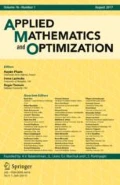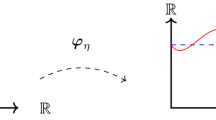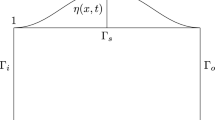Abstract
We consider a fluid–structure interaction model defined on a doughnut-like domain. It consists of the dynamic Stokes equations evolving on the exterior sub-domain, coupled with an elastic structure occupying the interior sub-domain. A key factor—a novelty over past literature—is that the structure equation includes a strong (viscoelastic) damping term of Kelvin–Voigt type at the interior. This affects the boundary conditions at the interface between the two media and accounts for a highly unbounded “perturbation”. Results include: (i) analyticity of s.c semigroup of contractions defining the overall coupled system, (ii) its (uniform) exponential decay, along with (iii) sharp spectral properties of its generator. Some results are geometry-dependant.



Similar content being viewed by others
References
Avalos, G., Triggiani, R.: The coupled PDE-system arising in fluid-structure interaction. Part I: Explicit semigroup generator and its spectral properties (with G. Avalos). AMS Contemp. Math. Fluids Waves 440, 15–55 (2007)
Avalos, G., Triggiani, R.: Uniform Stabilization of a coupled PDE system arising in fluid–structure interaction with boundary dissipation at the interface. Discret. Cont. Dyn. Syst. 22, 817–833 (2008)
Avalos, G., Triggiani, R.: Boundary feedback stabilization of a coupled parabolic-hyperbolic Stokes–Lamé PDE system. J. Evol. Equ. 9, 341–370 (2009)
Avalos, G., Lasiecka, I., Triggiani, R.: Higher regularity of a coupled parabolic-hyperbolic fluid–structure interaction system. Georgian Math. J. 15, 403–437 (2008)
Avalos, G., Lasiecka, I., Triggiani, R.: Heat–wave interaction in 2–3 dimensions: optimal rational decay rate. J. Math. Anal. Appl. 437(2), 782–815 (2016)
Balakrishnan, A.V.: Semigroups of Operators: Theory and Applications. Springer, Basel (1998)
Constantin, P., Foias, C.: Navier–Stokes Equations. University of Chicago Press, Chicago (1989)
Chen, G., Russell, D.L.: A mathematical model for linear elastic systems with structural damping. Quart. Appl. Math. 433–454 (1982)
Chen, S., Triggiani, R.: Proof of two conjectures of G. Chen and D.L. Russell on structural damping for elastic systems: the case \( \alpha = 1/2\) (with S.Chen). Springer-Verlag Lecture Notes in Mathematics 1354 (1988), 234–256. Proceedings of Seminar on Approximation and Optimization, University of Havana, Cuba (January 1987)
Chen, S., Triggiani, R.: Proof of the extensions of two conjectures on structural damping for elastic system. Pac. J. Math. 136, 15–55 (1989)
Chen, S., Triggiani, R.: Gevrey class semigroups arising from elastic systems with gentle dissipation: the case \( 0 < \alpha < \frac{1}{2}\). Proc. Am. Math. Soc. 110, 401–415 (1990)
Chen, S., Triggiani, R.: Characterization of domains of fractional powers of certain operators arising in elastic systems, and applications. J. Differ. Equ. 88, 279–293 (1990)
Chen, S., Triggiani, R.: Gevrey class semigroups arising from elastic systems with gentle perturbation. Proc. Am. Math. Soc. 110, 401–415 (1990)
Ignatova, M., Kukavica, I., Lasiecka, I., Tuffaha, A.: On well-posedness for a free boundary fluid–structure model. J. Math. Phys. 53, 15624 (2012)
Ignatova, M., Kukavica, I., Lasiecka, I., Tuffaha, A.: On wellposedness and small data global existence for an interface damped free boundary fluid–structure interaction model-. Nonlinearity 27(3), 467–499 (2014)
Kesavan, S.: Topic in Functional Analysis and Applications. New Age International(P)Ltd, Chennai (1989)
Kaltenbacher, B., Kukavica, I., Lasiecka, I., Triggiani, R., Tuffaha, A., Webster, J.T.: Mathematical Theory of Evolutionary Fluid–Flow Structure Interactions. Oberwolfach Seminars, Volume 48, Birkhauser
Kukavica, I., Tuffaha, A., Ziane, M.: Strong solutions to a nonlinear fluid–structure interaction system. J. Differ. Equ. 247, 1452–1478 (2009)
Kukavica, I., Tuffaha, A., Ziane, M.: Strong solutions to a nonlinear fluid–structure interaction system. Adv. Differ. Equ. 15, 231–254 (2010)
Lu, Y.: Uniform decay rates for the energy in nonlinear fluid–structure interaction with monotone viscous damping. PJM 2(2), 215–232 (2013)
Lasiecka, I., Lu, Y.: Asymptotic stability of finite energy in Navier–Stokes-elastic wave interaction. Semigroup forum 82, 61–82 (2011)
Lasiecka, I., Lu, Y.: Interface feedback control stabilization to a nonlinear fluid–structure interaction model. Nonlinear Anal. 75, 1449–1460 (2012)
Lasiecka, I., Triggiani, R.: Control Theory for Partial Differential Equations: Continuous and Approximation Theories, Vol. 1 (680 pp.), Vol. 2 (422 pp.). Encyclopedia of Mathematics and Its Applications Series, Cambridge University Press, Cambridge (January 2000)
Lasiecka, I., Triggiani, R.: Heat-structure interaction with viscoelastic damping: analyticity with sharp analytic sector, exponential decay, fractional powers. Commun. Pure Appl. Anal. 15, 1515–1543 (2016)
Lasiecka, I.,Triggiani, R.: Domain of fractional powers of matrix-valued operators: a general approach, invited paper. Operator Semigroups meet Complex Analysis, Harmonic Analysis and Mathematical Physics, Birkauser, Vol. 250, dedicated to C.Batty (2015), pp 297–311
Mahawattege, R.: Analysis and control of fluid-structure interaction with visco-elastic Kelvin–Voigt damping. PhD thesis, University of Memphis
Pazy, A.: Semigroups of Linear Operators and Applications to Partial Differential Equations. Springer, Berlin (1983)
Pruss, J.: On the spectrum of \(C_0\) semigroups. Trans. Am. Math. Soc. 284, 847–857 (1984)
Taylor, A., Lay, D.: Introduction to Functional Analysis, 2nd edn. Wiley, New York (1980)
Teman, R.: Navier–Stokes Equations and Non-linear Functional Analysis, North Holland, Amsterdam (1978). Differ. Int. Equ. 3, 503–522 (1990) (Also, preliminary version in Proceedings INRIA Conference, Paris, France (June 1988), Springer-Verlag Lecture Notes)
Triggiani, R.: Finite rank, relatively bounded perturbations of semi-groups generators. III. A sharp result on the lack of uniform stabilization. Differ. Int. Equ. 3, 503–522 (1990)
Triggiani, R.: A heat-structure interaction model with Neumann or Dirichlet boundary control at the interface: optimal regularity, control theoretic implications. Appl. Math. Optim. 73, 571–594 (2016)
Triggiani, R.: A matrix-valued generator \(A\) with strong boundary coupling: a critical subspace of \(D((-A)^{1/2})\) and \(D((-A^*)^{1/2})\) and implications. Evol. Equ. Control Theory 5(1), 185–199 (2016)
Triggiani, R.: Domain of fractional powers of the heat-structure operator with visco-elastic damping: regularity and control-theoretic implication. J. Evol. Equ. 17(1), 573–597 (2017)
Triggiani, R.: Linear parabolic-hyperbolic fluid-structure interaction models. The case of static interface. Chapter 2 in “Mathematical Theory of Evolutionary Fluid-Flow Structure Interaction”, pp. 53–172, Birkhauser (2018). Oberwolfach Seminars vol 48, B. Kaltenbacher, I. Kukavica, I. Lasiecka, R. Triggiani, A. Tuffaha, J. Webster
Triggiani, R.: Heat-viscoelastic plate interaction via bending moments and shear forces operators: analyticity, spectral analysis, exponential decay. Appl. Math Optim. 82, 755–797 (2020)
Triggiani, R., Zhang, J.: Heat–viscoelastic plate interaction: analyticity, spectral analysis, exponential decay. Evol. Equ. Control Thoery 1(1), 153–182 (2017)
Zhang, J.: The analyticity and exponential decay of a Stokes–Wave coupling system with visco-elastic damping in the variational frame work. Evol. Equ. Control Theory 6(1), 135–154 (2017)
Acknowledgements
The authors wish to thank two referees for their much appreciated comments. Research partially supported by the National Science Foundation under Grant DMS-1713506. This paper was written while R.T was a MSRI Research Professor during the 2021 Spring Semester, “Mathematical problems in fluid dynamics”, held at the Mathematical Sciences Research Institute, University of California, Berkeley.
Author information
Authors and Affiliations
Corresponding author
Additional information
Publisher's Note
Springer Nature remains neutral with regard to jurisdictional claims in published maps and institutional affiliations.
Rights and permissions
About this article
Cite this article
Mahawattege, R., Triggiani, R. Fluid–Structure Interaction with Kelvin–Voigt Damping: Analyticity, Spectral Analysis, Exponential Decay. Appl Math Optim 84 (Suppl 2), 1821–1863 (2021). https://doi.org/10.1007/s00245-021-09812-5
Accepted:
Published:
Issue Date:
DOI: https://doi.org/10.1007/s00245-021-09812-5




